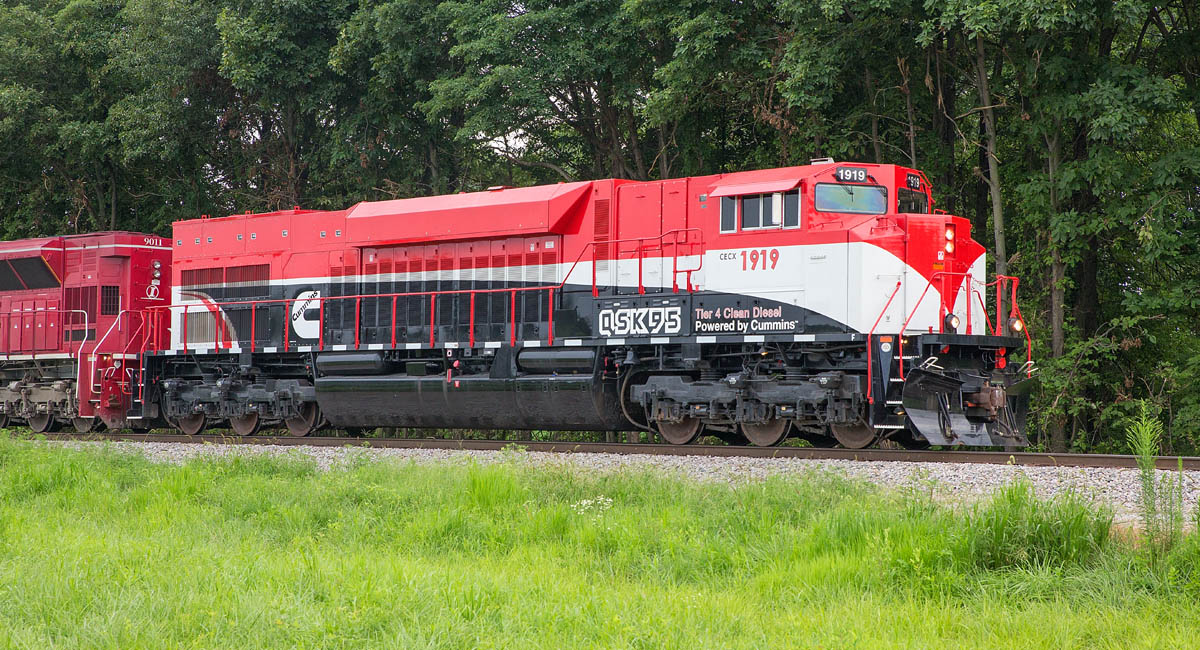Tier 0 covers locomotives built between 1973 and 2001; Tier 1, 2002-2004; Tier 2, 2005-2011; Tier 3, 2012-2014; and Tier 4, 2015-today. Regulations allow different emission standards for line-haul and switch locomotives to differentiate between locomotives and their typical duty cycles. While significant differences exist between the two in earlier tier levels, at Tier 4, line-haul and switch locomotive standards are essentially the same.
Four technologies are in use, and while they can be used to treat exhaust singly or in combinations, no solution uses all four.
Exhaust aftertreatment is just part of the complex puzzle that engine manufacturers must solve to achieve emission compliance. Engines can be tuned to emit different levels of each pollutant for treatment. Often adjusting the engine to address one pollutant can adversely affect another. For example, tuning an engine to a hotter combustion temperature reduces the particulate matter but increases nitrous oxide. Cooler combustion temperatures have an inverse effect.
Here are the four complex processes that are used to reduce engine pollutants.
DOC, short for Diesel Oxidation Catalyst. A diesel oxidation catalyst chamber is installed on top of the turbocharger and is primarily used to reduce carbon monoxide and hydrocarbons, but ineffective at reducing particulate matter and nitrogen oxide. It is commonly used in conjunction with other solutions for the other pollutants.
DPF, short for Diesel Particulate Filter. This reduces particulate matter by trapping it in filters. Buildup of particulate matter in the filter can cause a reduction of engine performance. One way trapped particulate matter can be burned is by hot exhaust gases passing through the filter in a process called passive regeneration. The filter also accumulates ash from engine oil burned in the cylinders, and requires periodic removal and cleaning.
EGR, short for Exhaust Gas Recirculation. While not technically an aftertreatment, it’s a recirculation system that takes a portion of the exhaust gas, cools it, and routes it back into the air intake where its mixed with fresh air for combustion again. The lower oxygen content of the recirculated air reduces the amount of nitrogen oxide created by the engine.
SCR, short for Selective Catalytic Reduction. This system requires an additive fluid called DEF, a urea and water solution, and is sprayed into the exhaust before entering the catalyst. When the solution mixes with the hot exhaust gas, it’s converted to ammonia and reacts with catalysts to reduce the nitrogen oxide. While this system reduces some hydrocarbons, carbon monoxide, and particulate matter, it’s most effective at reducing nitrogen oxide. The urea and water solution must be stored on the locomotive to avoid extreme temperatures. An engine with this system uses approximately one-half to 1 gallon of urea and water solution for every 10 gallons of diesel fuel burned.
| >>How to doctor diesel exhaust | ||||
| Current Tier 4 aftertreatment uses by builder (All engines certified Tier 4 Line-Haul except Cummins QSX15, which is a Tier 4 Switcher) |
||||
| Builder | Model |
Engine | Type | Emissions |
| EMD | F125 | Caterpillar C175-20 | V20 | SCR |
| EMD | SD70ACe-T4/ SD70ACeP4-T4 |
EMD 12-1010J | V12 | EGR |
| GE | ET44AC/ ET44C4 |
GE EVO-T4 | V12 | EGR |
| Siemens | SC-44 | Cummins QSK95 | V16 | SCR |
| Motive Power Inc. | MP54AC | (2) Cummins QSK60 | V16 | SCR |
| Brookville | BL12CG | Cummins QSX15 | I6 | EGR, DOC, DPF |
| National Railway Equipment | 2GS12B | Cummins QSX15 | I6 | EGR, DOC, DPF |
| Railpower | RP20BD | Cummins QSX15 | I6 | EGR, DOC, DPF |
| Knoxville Locomotive Works | SE24B | MTU S4000R54 | V12 | EGR, SCR, DOC |
| Knoxville Locomotive Works | SE32C | MTU S4000R54 | V12 | EGR, SCR, DOC |
| Railserve | DUAL LEAF | (2) Cummins QSX15 | I6 | EGR, DOC, DPF |















The bus industry is concentrating on reducing emissions using the DEF solution; a very expensive solution by the way. Regeneration is also required and if not done regularly engines simply shut down. Hopefully someone will eventually come up with a system that works without what I call add-ons. In the meantime it is expensive, time consuming and a pain in the a….
Unfunded mandate by the &^*% federal govenment.Farm,construction,mining equipment has been affected by these business costing regulations.These makers are depending too much on the Columbus,Indiana based company to get thru to this.This same company should stick with what its best with & stay the heck out of powering locomotives
Over the road truckers have long since found that EGR is ruinous to diesel engines, irrespective of manufacture.Which begs the question–how come it works in a locomotive? I can’t believe the experiences of thousands of truckers are all wrong or that size matters or that rubber tires lack some magic steel wheels have; Any answers out there?